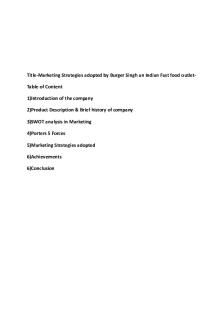Formulating Marketing Strategy PDF

| Title | Formulating Marketing Strategy |
|---|---|
| Course | Human Resource Management Systems |
| Institution | British Columbia Institute of Technology |
| Pages | 35 |
| File Size | 613.2 KB |
| File Type | |
| Total Downloads | 83 |
| Total Views | 126 |
Summary
(taken from Net)...
Description
The Process of Formulating and Implementing Marketing Strategy by Sebastian Salicru
The Process of Formulating and Implementing Marketing Strategy External environment
Corporate objectives & strategy Business-level objectives & strategy Market opportunity analysis • environmental & competitor analysis • marketing information • industry dynamics • customer analysis, segmentation & targeting decisions • positioning decisions
Formulating strategies for specific market situations • strategies for new market entries • strategies for growth markets • strategies for mature and declining markets
Implementation & control Walker et al. (1999)
• implementing business & marketing strategies • controlling marketing strategies & programs
The Process of Formulating and Implementing Marketing Strategy (cont.) 1.
Interrelationships between different levels of strategy.
2.
Market Opportunity Analysis.
3.
Formulating strategies for specific market situations.
4.
Implementation and Control.
1.
Interrelationships between different levels of strategy: Marketing strategy should be aligned with corporate and business level strategies . The marketing program for an individual product must be consistent with the strategic direction, competitive thrust and resources allocations decided on at a higher management level.
Corporate Mission Statement (qualitative, philosophical)
Corporate (business) objectives (quantifies and operationalises the mission statement)
Functional objectives eg marketing, financial, production, engineering (quantitative, measurable)
McDonald (1990
2.
Market Opportunity Analysis: A major factor in the success or failure of a strategy at any level is whether it fits the realities of the firm’s external environment. Thus, the first step is to monitor and analyze the opportunities and threats posed by factors outside the organization.
2.1 Environmental, industry and competitor analysis: We must first attempt to identify and predict the impact of broad trends in the economic and social environment.
2.2
Customer analysis: segmentation, targeting and positioning. The primary purpose of any marketing strategy is to facilitate and encourage exchange transactions with potential customers. Hence, we need to analyse the motivations and behaviours of present and potential customers.
Not every potential customer will have the same needs, seek the same product benefits, or be influenced in the same way by the same marketing program. Hence, we must determine whether there are multiple market segments that will respond differently to our products/services and marketing programs, and how to best define, identify and appeal to those segments.
Not every segment market will be equally attractive for the firm. Hence, the next step is to target and position the product/service in the target segment relative to competitive offering.
3.
Formulating strategies for specific market situations: The strategic marketing program for a particular product/market entry should reflect market demand and the competitive situation within the target market. As demand and competitive conditions change over time, the marketing strategy should be adjusted accordingly.
4.
Implementation and Control: A final critical determinant of a strategy’s success is the firms’ ability to implement it effectively. This, in turn, depends on whether the strategy is consistent with the firm’s resources, organisational structure, coordination and control systems, and skills and experience of its people.
Corporate Strategy Decisions Setting Marketing Objectives and Strategies
Corporate Strategy Decisions v
Corporate Development Strategy
v
Allocating Corporate Resources
Corporate Development Strategy Essentially, a firm can go into major directions in seeking future growth: Ø Expansion of its current business and activities or ØDiversification into new business through either internal business or acquisition.
Expansion: §
Market penetration
§
Product development
§
Market development
Diversification: §
Vertical integration
§
Related diversification
§
Unrelated diversification
§
Diversification through organisational relationship or networks
Ansoff Matrix: (How to set marketing objectives) A firm’s competitive situation can be simplified to two dimensions only – products and markets. Simply put, Ansoff’s framework is about what is sold (the ‘product’) and who is sold to (the ‘market’).
Ansoff Matrix (Cont.) (Four possible courses of action) 1.
Selling existing products to existing markets.
2.
Extending existing products to new markets.
3.
Developing new products for existing markets.
4.
Developing new products for new markets.
Ansoff Matrix Increasing technological newness
New
Present
Increasing market newness
Present
Market penetration
Product development
New
MARKET
PRODUCT
Market extension
Diversification
Alternative Corporate Growth Strategies Current products
Current markets
New markets
Walker et al. (1999)
New products
Market penetration Strategies
Product development Strategies
• increase market share • increase product usage - increase frequency of use - increase quantity used - new applications
• product improvements • product-line extensions • new products for same market
Market development Strategies
Diversification strategies
• expand markets for existing products - geographic expansion - target new segments
• vertical integration forward integration backward integration • diversification into related businesses (concentric diversification) • diversification into unrelated businesses (conglomerate diversification)
Allocating Corporate Resources Ø
Portfolio models
Ø
Value-based planning
Portfolio models: The Boston Consulting Group’s (BCG) Growth-Share Matrix
The Boston matrix classifies a firm’s products according to their cash usage and their cash generation along the dimensions of relative market share and market growth rate. Market share is used because it is an indicator of the product’s ability to generate cash. Market growth is used because it is an indicator of the product’s cash requirements.
The BCG Growth-Share Matrix High
Stars
Question Marks
Market Growth Rate Cash Cows
Dogs
Low High
Relative Market Share
Low
The BCG Growth-Share Matrix High
Market Growth Rate
‘Stars’ Cash generated + + + Cash used - - ________ 0
‘Cash Cows’ Cash generated + + + Cash used _______ ++
‘Question Marks’ Cash generated + Cash used - - _______ --
‘Dogs’ Cash generated + Cash used _______ 0
Low High
Relative Market Share
Low
The BCG Growth-Share Matrix High
Market Growth Rate
‘Stars’ Cash generated + + + Cash used - - ________ 0
The ‘Star’ is probably the newest product that has achieved high market share and which is probably more or less self-financing in cash terms.
Low High
Relative Market Share
Low
The BCG Growth-Share Matrix High
Market Growth Rate
The ‘Cash cows’ are leaders in markets where there is little additional growth, but a lot of stability. They are excellent generators of cash and tend to use little because of the state of the market. ‘Cash Cows’ Cash generated + + + Cash used _______ ++
Low High
Relative Market Share
Low
The BCG Growth-Share Matrix High
Market Growth Rate
‘Dogs’ often have little future and can be a cash drain on the firm. They are probably candidates for divestment, although often such products fall into a category described as ‘investments in managerial ego’. ‘Dogs’ Cash generated + Cash used _______ 0
Low High
Relative Market Share
Low
The BCG Growth-Share Matrix High
Market Growth Rate
Low
‘Question Marks’ The ‘Question mark’ is a Cash generated + - - product which has Cash used _______ not yet achieved a -dominant market position and thus a high cash flow. This is also It will be a high sometimes user of cash referred as a because it is in a ‘wildcat’. growth market.
High
Relative Market Share
Low
The art of product portfolio management now becomes a lot clearer. What we should be seeking to do is to use the surplus cash generated by the ‘cash cows’ to invest in our ‘stars’ and in a selected number of ‘question marks’
The BCG Growth-Share Matrix High
‘Stars’
‘Question Marks’
Market Growth Rate ‘Cash Cows’
‘Dogs’
Low High
Relative Market Share
Low
The BCG Growth-Share Matrix High
‘Stars’
‘Question Marks’
Market Growth Rate ‘Cash Cows’
‘Dogs’
Low High
Relative Market Share
Low
Using Ansoff’s Matrix to determine Marketing Directions Cash Cows Question marks
Maintain
Grow or Exit
Stars
Improve
Dogs
Harvest or Exit
Ansoff
Direction
The Major Forces that Determine Industry Competition
Threat of new entrants
Bargaining strength of suppliers
Competition among existing industry firms
Threat of substitute products
Porter
Bargaining strength of buyers...
Similar Free PDFs

Formulating Marketing Strategy
- 35 Pages

Marketing Strategy
- 5 Pages

marketing strategy
- 5 Pages

Hyundai\'s Marketing Strategy
- 3 Pages

LG\'s marketing strategy
- 3 Pages

PMK-Apple\'s marketing strategy
- 26 Pages

Digital marketing strategy Essay
- 7 Pages

Netflix marketing strategy
- 2 Pages

International Marketing Strategy
- 68 Pages

Burger singh marketing strategy
- 16 Pages

Vivo\'s marketing mix strategy
- 4 Pages

International Marketing Strategy
- 52 Pages

Dimensions of marketing strategy
- 2 Pages
Popular Institutions
- Tinajero National High School - Annex
- Politeknik Caltex Riau
- Yokohama City University
- SGT University
- University of Al-Qadisiyah
- Divine Word College of Vigan
- Techniek College Rotterdam
- Universidade de Santiago
- Universiti Teknologi MARA Cawangan Johor Kampus Pasir Gudang
- Poltekkes Kemenkes Yogyakarta
- Baguio City National High School
- Colegio san marcos
- preparatoria uno
- Centro de Bachillerato Tecnológico Industrial y de Servicios No. 107
- Dalian Maritime University
- Quang Trung Secondary School
- Colegio Tecnológico en Informática
- Corporación Regional de Educación Superior
- Grupo CEDVA
- Dar Al Uloom University
- Centro de Estudios Preuniversitarios de la Universidad Nacional de Ingeniería
- 上智大学
- Aakash International School, Nuna Majara
- San Felipe Neri Catholic School
- Kang Chiao International School - New Taipei City
- Misamis Occidental National High School
- Institución Educativa Escuela Normal Juan Ladrilleros
- Kolehiyo ng Pantukan
- Batanes State College
- Instituto Continental
- Sekolah Menengah Kejuruan Kesehatan Kaltara (Tarakan)
- Colegio de La Inmaculada Concepcion - Cebu


